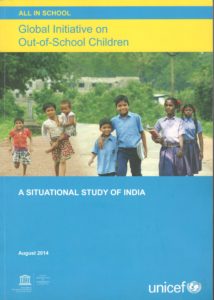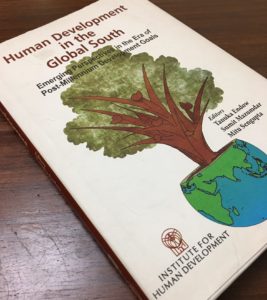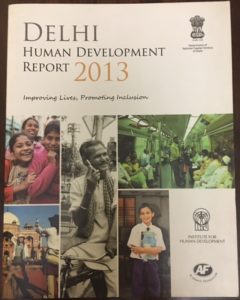1. Global Initiative on Out-of-School Children – A Situational Study of India: Aug 2014
A UNICEF Report prepared by CORD (Collaborative Research And Dissemination) team led by Anuradha De and Tanuka Endow and supported by Claire Noronha, Chander Shekhar Mehra and Rajeev Kumar.
Executive Summary:
The Global Initiative on Out-of-School Children initiated by UNICEF and the UNESCO Institute for Statistics (UIS) aims to apply a more systemic approach to addressing the problem of exclusion in education, including the use of a more standardised methodology to analyse data and profiles of out-of-school children and those at risk of dropping out. This report is part of the Global Initiative and focuses on out-of-school children in India. It draws on official administrative survey and large household surveys, as well as on focused  research studies, both quantitative and qualitative. In India, education data from various sources are available and the Report examines them in the context of their relevance for the estimation of out-of-school children in the 5 to 13 age group. The relevant data sources are identified and are used to estimate the number of out-of-school children, and to analyse their profile. This Report also identifies the different barriers that have kept these children out of school, and examines the different policies that have been implemented to address these barriers. The concluding section of the Report draws together insights from the preceding sections, and proposes some data related recommendations.
research studies, both quantitative and qualitative. In India, education data from various sources are available and the Report examines them in the context of their relevance for the estimation of out-of-school children in the 5 to 13 age group. The relevant data sources are identified and are used to estimate the number of out-of-school children, and to analyse their profile. This Report also identifies the different barriers that have kept these children out of school, and examines the different policies that have been implemented to address these barriers. The concluding section of the Report draws together insights from the preceding sections, and proposes some data related recommendations.
This Report was referenced by the UNICEF sponsored South Asia Regional Study on Out-of-School Children covering Bangladesh, India, Pakistan and Sri Lanka
Availability: http://uis.unesco.org/sites/default/files/documents/a-situational-study-of-india-out-of-school-children-en.pdf
2. Human Development in the Global South: Emerging Perspectives in the Era of Post-Millennium Development Goals
Editors: Tanuka Endow, Sumit Majumdar, Mitu Sengupta
This volume comprises a revised and updated version of the collection of thematic papers, country perspectives and commentaries from leading scholars from the Global South on key human development challenges from the perspective of the global consultative process on the post-Millennium Development Goals agenda. These papers were presented and deliberated critically at the International Symposium on Human Development in the Global South Emerging Perspectives in the Era of Post-Millennium Development Goals (Apr 28-29 2014, New Delhi), jointly organised by the Institute for Human Development (IHD), New Delhi in collaboration with the Wada Na Todo Abhiyan (WNTA) and the United Nations Economic and Social Commission for Asia and Pacific (UNESCAP), South and West Asia office.

The international development discourse is presently focused on the new development framework that will replace the existing set of eight Millennium Development Goals in 2015, slowly crystallising around a new set of goals, being termed as ‘Sustainable Development Goals’.
Since the MDGs were drawn up in 2000, Southern countries, and specially many South Asian countries, have emerged as key players on the world stage. Moreover these are also the countries with major human development deficits. It is imperative, therefore, the Southern voices are heard and have a leading role in setting the agenda for development in the post-2015 years. Several knowledge products have emerged out of these consultative discourses, including a recently published collection of brief commentaries or Think Pieces.
Part 1: Some Key Aspects Of Human Development In The Global South
Growth And Inequality: The Post-MDG Context For India
Author: Tanuka Endow
Introduction: India has been experiencing a high growth rate during much of the post-liberalisation period following the economic reforms initiated in early 1990s. As one of the fastest growing economies of the world, it has made great strides in many areas, such as information technology, pharmaceuticals and automotive parts, among others, and has emerged as a major player in the world economy. as a positive outcome, poverty levels have declined and there have also been some improvement in several indicators of human development, such as literacy, health and nutrition and access to some basic amenities.
In spite of these positive developments, however, India lags behind many countries in the world in terms of human development. India ranks 135th out of 187 countries by the Human Development Index (HDI), with a value of 0.586 for the HDI, according to the 2014 Human Development Report (UNDP, 2014).
3. Delhi Human Development Report 2013
Editor: Alakh N Sharma
Associate Editors: Tanuka Endow, Nandita Gupta, Usha Jayachandran
Preface: The discourse on human development has come a long way since the publication of the first global Human Development Report was published in 1990. Ever since then, people have become central to development issues, with the main concerns being that all sections of the society should benefit
from economic prosperity, enjoy long, healthy and productive lives, and optimise their potential in all spheres.
Proceeding with a similar sensibility, the first Human Development Report for Delhi was published in 2006, and was structured around the central theme of
‘Partnerships for Progress’. The Report highlighted the need for increased
people’s participation in order to achieve progress in human development on the basis of the partnerships forged between the community and the Government.
The theme of the Delhi Human Development Report, 2013, the successor to the first Human Development
Report of 2006, is “Improving Lives, Promoting Inclusion”. This theme is particularly relevant for Delhi in the context of the multi-layered society of this great megapolis, wherein the wealthy and the poor live side by side, where opulent mansions and crowded slums jostle for space with each other, and where people speak in myriad tongues and follow a multitude of cultures.
The economy of Delhi has witnessed a high growth rate during the last decade. Poverty has been reduced considerably. There has been an expansion
in employment opportunities as well as in access to housing and many basic services. Public health facilities and educational opportunities have undergone tremendous expansion. This has been reflected in a very high level of satisfaction expressed by people across the board regarding the various
aspects of life in Delhi. Notwithstanding the overall impressive gains accruing to various groups, however, disparities still persist amongst these groups. There are some particularly vulnerable groups of people such as the homeless, child workers, the differently abled and the elderly, whose relative exclusion based on human development considerations, warrants
focused attention from policy-makers. Public safety has recently emerged as a major area of concern bringing forth an important aspect of human
development. This Report has been prepared by a group of dedicated researchers at the Institute for Human Development (IHD), who have prepared background
papers based on their subject matter specialization and has been synthesised and edited by an experienced team. The preparation of the Report has benefited from the involvement of a high level Steering Committee chaired by the Chief Secretary, GNCTD. The Report has been enriched by the views
of the people of Delhi through a perceptions survey of about 8000 households, conducted by IHD, and also through focus group discussions (FGDs). The Report has benefited greatly from the organisation of
various thematic consultations and a comprehensive stakeholder workshop inaugurated by the Chief Minister of Delhi, which entailed brainstorming
sessions among national and international academicians and researchers, and discussions and feedback from Government officials/departments. These interactions helped garner a lot of enriching and useful inputs for incorporation into the Report. Our sincere endeavour in preparing this Report
comes with the hope that it would become a tool for evidence-based policy formulations, thereby facilitating a better understanding of the various
attributes that underlie the human development paradigm, especially in the context of Delhi. It has been a great privilege for the Institute for Human Development to be associated with the preparation of the Delhi Human Development Report 2013. The Institute is grateful to the Government of
Delhi for providing it this opportunity. The conduction of a Perceptions Survey, encompassing various issues directly related to human development, helps in
bringing the voice of the residents of Delhi to the fore and highlighting people’s feelings about the quality of their lives as residents of this city. Various inter linkages exist between the availability of human development-related services such as education, healthcare, basic services, and safety, and the perceptions of the people who avail of these services, especially the vulnerable and the marginalised. These links at the locality/neighbourhood, household and individual levels need to be understood closely in order to efficiently address the pervasiveness of various disparities as well as to assure better access and utilisation of essential services thereby
promoting inclusion. The DHDR 2013 is a small but steady step in this direction.
Availability: http://www.indiaenvironmentportal.org.in/files/file/delhi%20human%20development%20report%202013.pdf
4. Dealing With Trade Distortions In Steel Industry
Authors: Veena Jha, James Nedumpara, Tanuka Endow
A co-publication of UNCTAD and Macmillan India Ltd
This book examines the efforts made at reducing or removing the steel subsidies and for forging an agreement for limiting the scope of such

subsidies particularly at the Organisation of Economic Cooperation and Development (OECD) level. The book finds that the ‘one size fits all’ approach hitherto followed at the steel talks, which effectively shields the existing subsidy schemes of many developed countries, might end up limiting the aspirations of developing countries that have a significant projectes demand growth for steel.
It is often difficult to quantify the subsidies given in the steel sector. Many subsidy programmes operated by developed and developing countries are available to a wide range of industries and are seen in effect to benefit certain industries, such as steel, disproportionately. In this context, the ‘price gap’ approach used in the study forms a viable basis to target non-specific subsidies, which are hidden and are difficult to identify.

